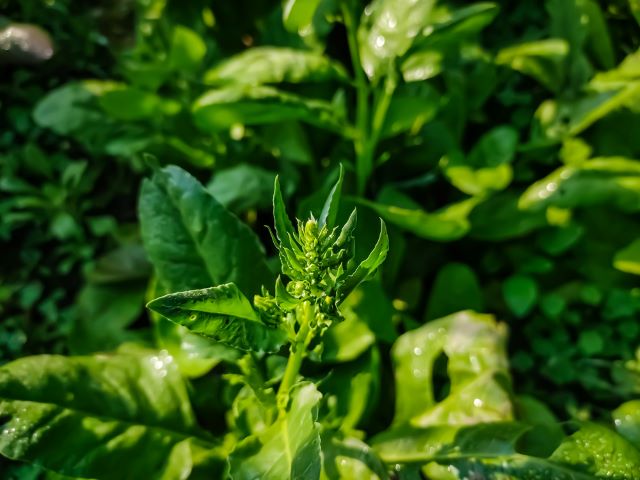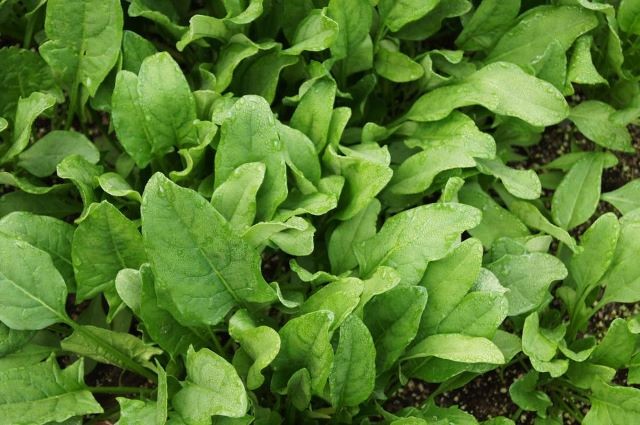Fast growing, easy to maintain, and packed with nutrients, spinach has to be one of my all-time favorite crops to grow and cook with. Spinach also requires remarkably little maintenance once you’ve got it going. And, if the conditions are right, spinach can provide you with a steady, self-replenishing harvest of tasty, tender leaves for months.

But what happens if your spinach is flowering too soon? If the spinach leaves are turning bitter, the plant is suddenly growing tall, and the blooms are coming through, this is probably because it has ‘bolted’.
Spinach flowers when the temperature is too high, there is a lack of nutrients in the soil or the plants are grown too closely together.
Flowering is a natural part of your spinach’s life cycle and isn’t necessarily a cause for concern. However, if it’s taking place too early for you to have received a decent harvest from your crop, there are things you can do to try to slow the process down or avoid it happening prematurely the next time you plant.
Table of Contents
What is Bolting?
Bolting is a process that many leafy edible crops go through at the end of their individual life cycles. It is essentially the point at which your spinach feels it’s got as much as it can hope to get out of the garden it’s in and decides to flower, seed, and die in order to make way for the next generation of spinach plants.
The process can happen quite quickly, sometimes within a matter of days. You may notice your spinach leaves turning from rounded oval shapes to more angular, arrow-like shapes.
At the same time, the taste of the spinach leaves will turn bitter, eventually to the point of being inedible.
The spinach plant will send up a central stalk which develops small clusters of flower buds. These blooms will eventually produce seeds before the spinach plant withers and dies.
When Does Bolting Occur in Spinach Plants?
There are numerous factors that can result in your spinach entering the end of its life cycle. But typically the temperature of your garden is likely to be the most common cause.
Spinach is a cool-weather crop that prefers temperatures between 41-75 °F (5-23 °C). If temperatures start climbing above this for more than a very brief spell, this is likely to cause the spinach crop to bolt and flower.
Similarly, if the spinach plant feels it can no longer be productive due to a lack of nutrients in the soil, or because it is in too much competition with other plants packed closely around it, this can also accelerate the process of bolting.
Anything that causes your spinach to sense that it may no longer be able to thrive can result in it opting to go to seed.
How to Avoid Spinach Prematurely Flowering

As you have probably realized already, bolting and flowering is a natural and ultimately inevitable part of your spinach’s life cycle. You can’t stop nature from doing its thing! Nevertheless, there are things we can do to help our spinach remain productive and producing tasty leaves for as long as possible.
Plant Spinach Early
Give your spinach plants as much chance as possible to grow in the right weather conditions by planting early in the growing season. For temperate climates, this usually means planting early in the spring or planting straight after the hottest period of summer.
Most varieties of spinach are relatively fast-growing, maturing in approximately 7 or 8 weeks.
If possible, you want to try to give the plant at least 3 months at optimum temperature in order for it to keep producing leaves up until the chill of winter or the hot days of summer bring the harvest to a close.
Plant Bolt-Resistant Spinach Varieties
Although no spinach is going to be entirely bolt-resistant, there are varieties you can choose which have been developed to resist bolting as soon as the temperature rises.
Spinach varieties tipped as being relatively bolt-resistant include Giant Nobel, Avon F-1 Hybrid, Oceanside, Indian Summer, and Catalina, among others.
To keep a harvest going for as much of the year as possible, some spinach-loving gardeners plant varieties that enjoy the cooler weather as early in the spring as possible. Then gradually plant more heat-resistant spinach varieties as the months become hotter.
This crop rotation can mean you have a relatively reliable harvest of spinach well into the summer months.
Keep Spinach Well Fed
Spinach likes nitrogen-rich soil in order for it to provide strong, vibrant, leafy growth throughout its lifespan. It’s a good idea to plant spinach in well-worked, loose soil amended with compost or aged manure. You can also add nitrogen-focused organic fertilizer to help it along.
Keep mature spinach plants spaced roughly 4-6 inches apart. The best way to manage this is by thinning out seedlings as they grow. And leave the healthiest looking ones to keep in the garden.
Not only will this spacing mean your spinach isn’t in harmful competition with its bedfellows, it can also help reduce the risk of diseases and pest infestations.
Keep Spinach Well Watered
Spinach needs to be in moist, well-watered soil during the warmer months. Otherwise, spinach may feel it’s time to give up the ghost and bolt! Mulching the bed can help retain moisture.
You can also opt to plant your spinach in a micro-climate. One that promotes the retention of water in the soil during the hotter months. This could include planting spinach near a water source. Such as a pond or irrigation canal. Or in partial shade, if your garden is particularly arid and exposed.
You can also protect your spinach during the sunny seasons by placing some temporary shade around it. You can do this by constructing a shelter or by using shade cloth. Although spinach prefers sunny spots, it can survive being placed in partial shade.
In fact, more than 14 hours of sun a day is enough to make most spinach varieties feel as if they’ve reached the end of the line and enter into their flowering stage.
Harvest Spinach Leaves Regularly
Make sure you’re harvesting outer spinach leaves regularly so that the plant is prompted into producing more.
Regular harvesting not only extends the lifespan of the plant, it makes sure you’re getting the most from your spinach crop throughout the harvest season!
Remember, spinach leaves can be eaten fresh, cooked down, or wilted and frozen for future use.
What To Do If Your Spinach Has Flowered
If the tell-tale signs of bolting are already there, there are a few things you can do to try to slow the process, although it may be best to let nature run its course.
Taste test some of the smaller spinach leaves to see if they are still edible. You may find that some are not yet bitter enough to warrant you stopping harvesting altogether just yet!
Whilst trying to get as much spinach for your kitchen as possible, pinching out developing flower buds or cutting down any thick, long developing spinach stalks in the center of the plant can slow the bolting process.
For those wishing to maximize their garden’s production of edibles, one option is to pull up your spinach at the first sign of bolting and plant an alternative, warm-season crop in its place in order to get the most out of your bed. Bush beans can be a great post-spinach planting option, as they tend to grow fast in warm soil and produce well in late summer months.
If this all sounds a bit too frantic for you, why not just let your spinach do its thing? Enjoy the spinach flowers as they come through, which will also feed beneficial insects including bees.
Then wait until the spinach seeds are completely dry and the plant is starting to brown. At this point, you can gently shake the spinach seeds into an envelope. Seal them and keep them in a dry, cool place until the following growing season, when you can plant again. In my case, I just let spinach seeds drop in the garden where they self-seed and grow again the following season.
Related reading:
